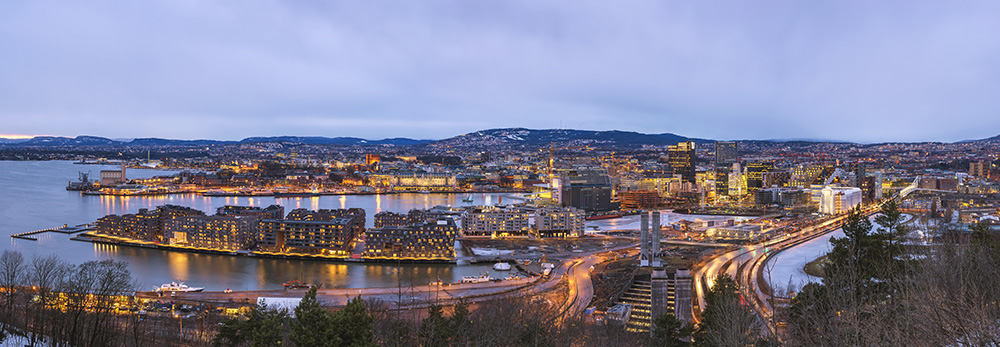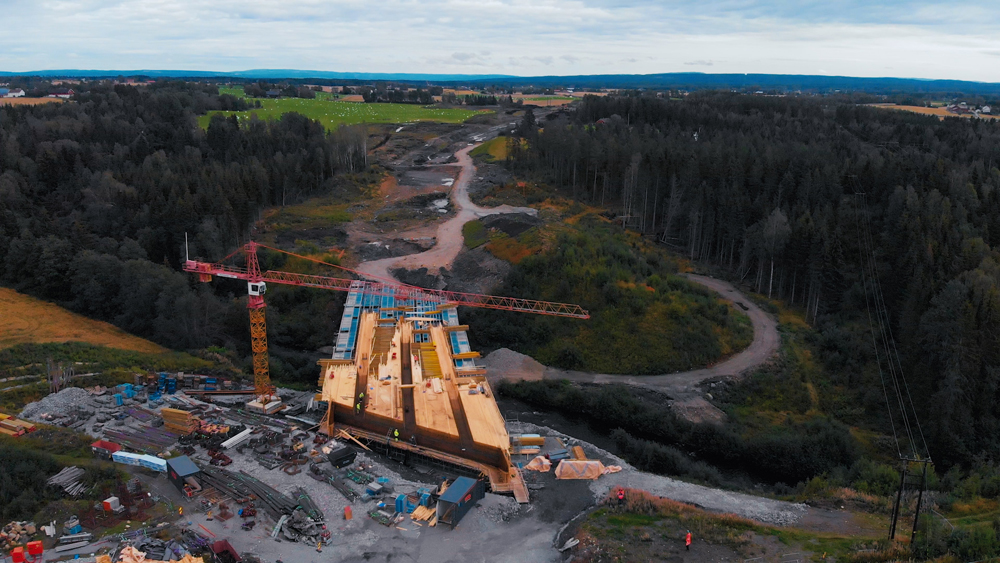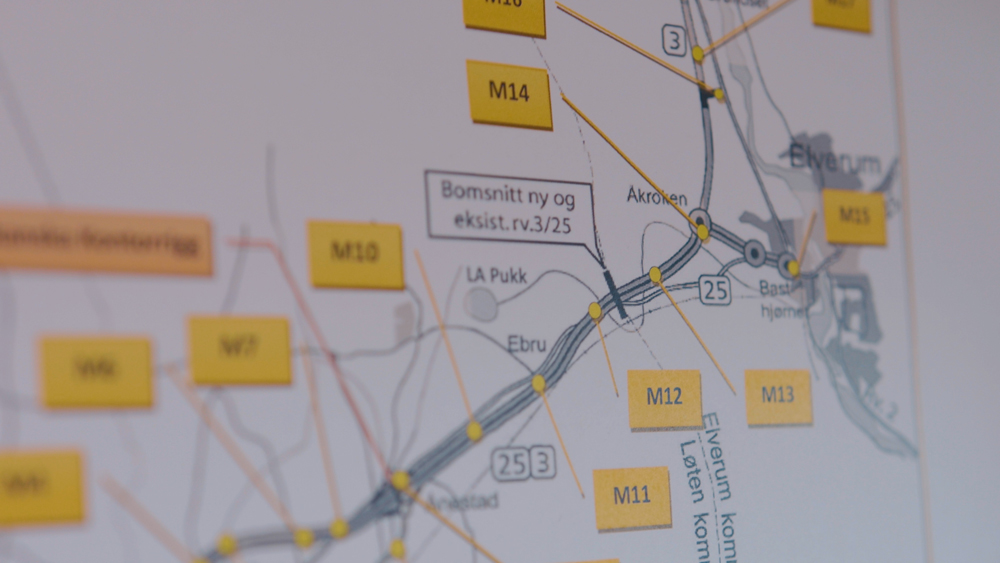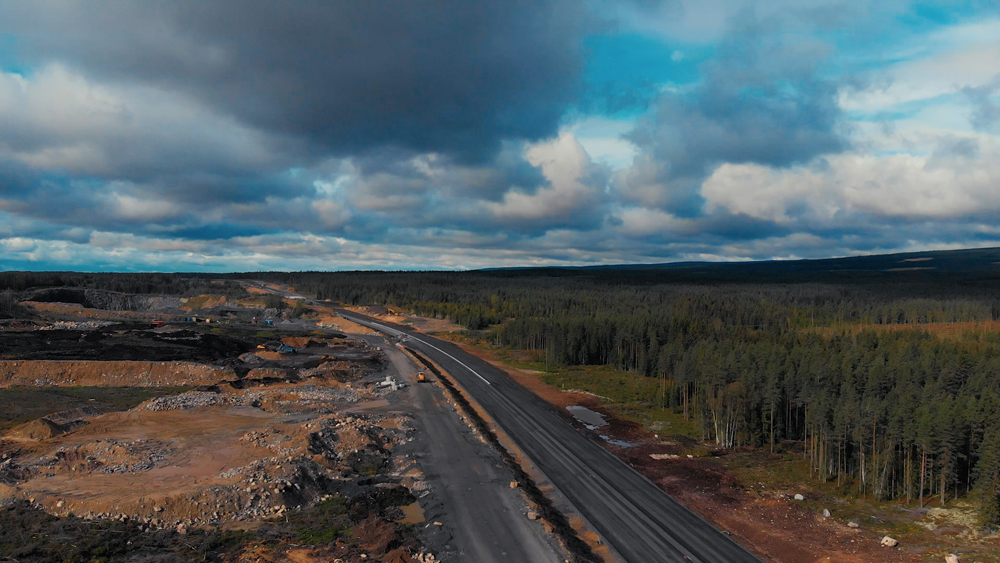
A new highway stretch in Norway will help cut journey times between the capital city, Oslo, in the south of the country and the nation’s third largest city, Trondheim, in the north. Driving the 495km route has typically taken around 6 ¾ hours, but a new 27km highway stretch will reduce journey times.
Named The Green Shortcut (Den Grønne Snarvei), this new highway stretch offers an alternative route that reduces the distance between the two cities by around 40km, compared with the existing E6. Using this stretch reduces the journey time by around 45 minutes to some 6 hours, allowing fuel savings for drivers also.

The Riksvei 3/25 is one of Norway’s most important national roads as it connects the south of the country with the north. Improving the road has proven a significant task for the Norwegian Public Roads Administration (NPRA) as the route passes through scenic natural landscapes and as a result, posed environmental challenges for the builders.
Although this new stretch is just 27km long, it features 28 separate civil engineering structures and has been built with two lanes in either direction. The project also features 7km of cycle lanes and facilities for pedestrians, a new traffic station for the road administration and a number of wildlife crossings.
Given the environmental sensitivity of the area, this has presented the builders with complex issues when it came to construction. Planning for the project commenced around a decade before any construction work got underway as the NPRA was keen to involve the local community and allay any concerns, as well as address the environmental aspects from early on. By planning ahead, the firm was able to work around numerous issues ahead of time and well before any construction actually commenced.
Arne Meland, project manager at the NPRA said, “I’ve worked on this project for about 10 years. The big idea is to establish a good road connection through Østerdalen, but to do that involves moving a lot of soil and rock masses and handling different types of terrain.”

But in addition to the geological challenges, the builders also had to take into account numerous safety and environmental measures. Meland explained, “Traffic safety is always the most important aspect, but limiting the impact on the environment and the local community is crucial, too.”
When the NPRA started the bidding process for the contract, the organisation had to take more than just the cost of the tenders being made into account. Those contractors entering the bidding were assessed for their experience as well as for their ability to plan the working and also schedule operations efficiently, so as to minimise the disturbance to the area. Five contractors submitted bids for the project but the NPRA selected Skanska to handle the work at the end of May 2018.
This section of national road, the Rv 3/Rv 25, lies between Løten and Elverum, in Hedmark county, around 100km to the north of Oslo. The project is of note as it is the first PPP project being carried out in Norway for over 10 years and is also one of the largest single road projects ever carried out in Norway.
The PPP contract is worth around €558 million, of which around €260 million, relates to the construction contract. This deal was included in Skanska’s Nordic order bookings for the second quarter of 2018, with the concession package being for a 20-year period. Construction commenced in the second quarter of 2018 and was originally due to for completion in late 2020. However, using the software has brought forward the completion date considerably.
Because of the complexity of the work and the geological and environmental factors, building the link has involved the use of some of the latest construction technology from Bentley Systems and Topcon Positioning, and software in particular playing a key role. The two firms established a joint venture to set up the Digital Construction Works business in 2019. According to the two companies, Digital Construction Works provides expert assistance to engineers and contractors working on infrastructure projects. The partnership has also been a major step forward in digitalisation of construction and is intended to help deliver the increased productivity required in construction.

In fact, the highly sophisticated construction software also played an important role in Skanska winning the package of work. By utilising this construction software during the bidding phase, Skanska was able to optimise the alignment and reduce the quantity of material needing to be moved during construction. The haulage distance for the materials was also optimised. This delivered a significant reduction in the estimated budget required for this portion of the project of some 20%.
This ability to reduce the cut and fill requirements as well as the haulage distances were important as the scale of the operation was a key challenge that the contractor faced. Even with the optimised design there was a need to remove some 4 million m3 of earth and rock along the alignment. For Skanska, this presented a logistical issue, with the material needing to be hauled away from the excavations and then either stockpiled for later use or relocated in a disposal area. At the same time, the software allowed the contractor to maintain both safety and quality standards during operations.
Discussing the movement and storage of the excavated material with the local farmers was crucial as the area has a strong agricultural sector. The firm had to ensure that its construction operations had minimal impact on the farming community in the area, avoiding damage to any fertile land in use by the agricultural sector.
To further boost its green credentials, Skanska has been using other more sustainable construction processes during this project, such as sourcing low-carbon concrete, maximising the use of recycled materials and optimising transport logistics so as to reduce traffic movements in the area.

Being able to use the Topcon software proved extremely valuable with regard to transporting all the excavated materials in the most efficient manner, as well as scheduling the vehicle movements along the full length of the site. According to the Skanska team this helped in reducing transport costs significantly, as well as lowering fuel consumption for the equipment used and also reducing tailpipe emissions from the plant and vehicles.
The software also helped in fine-tuning the design of the road, minimising the quantity of material being excavated, whether earth or rock. As the firm has used the Topcon technology previously, it was able to benefit from having a technical team that already had experience of the Bentley and Topcon packages and was able to implement this efficiently from the start of the project.
By providing a more streamlined flow with digital earthworks, Topcon claims that its software assists users in visualising the project data in a single view. An array of different design options can be assessed, such as how they affect project cost. The user can use the package to generate accurate earthworks plans, while the software also allows location-based construction planning and scheduling. This means that the user can manage traffic planning and site safety, as well as dealing with delays caused by late material deliveries or equipment breakdowns for example. The firm says that with all of this data being managed in one place, the user can work around any issues far more efficiently and deal with any problems quickly, minimising the impact on construction operations.

For Skanska and the Green Shortcut, the use of the software package provided a number of benefits. The software was able to highlight cost and time savings for both the design and construction stages. Marcus Wiksten, business development manager for Topcon software solutions, said: “The software includes optimisation technology. This means the Skanska team could coordinate the 120 excavators, trucks and dumptrucks on site and then recreate movement to reduce transportation, while making sure everything was where it needed to be.”
Lucia Calzado Teruel, planner for Skanska, added that softwware has added significant benefits for overall project efficiency: “You get all the information on mass haul, line-of-balance plans, Gantt charts and reports in one file. Before I started using Magnet, I needed different files that didn’t work together. Magnet is much more time efficient and ensures you deliver high-quality work.”
By using the software, the contractor has been able to model and simulate design options before construction, highlighting any issues such as clash detection for example. This has proved extremely valuable throughout the design and construction of the Riksvei 3/25 project. Niclas Törnroos, who was the project planning consultant from Topcon working for Skanska in the bidding stage of the project, said: “In the first stages of planning, Magnet was used to study how changes to the road alignment could get the most effective use of soil and rock masses. Original thoughts were to move approximately 4 million m3 of loose materials and replace it with 2 million m3 of crushed stone back on top.”

However, Tom-Arne Gullord, project engineer at Rv3/25, explained: “By using Magnet to optimise the mass hauls and scheduling, Skanska was able to reduce the mass that needed to be moved, which in turn cut costs and lessened the environmental impact.”
Meanwhile, Ketil Sand, project director at Skanska, commented, “Topcon’s contribution is partially Magnet software and partially having access to people who are highly skilled in using that software. The key to success is the harmony between software, key people and our own staff; Topcon has been very important to this project.”
Overall, the use of the Magnet package has helped Skanska to reduce planning and construction budgets on Riksvei 3/25 by 20%. The package has also helped the contractor and the State Highways Authority to meet the tough environmental requirements for the project. In addition to reducing the time needed for the construction of the project, the contractor has also been able to achieve a 20% reduction in greenhouse gas emissions from the site. Through the use of the software’s planning capabilities, Skanska has been able to cut down transport trips and reduced the onsite operations required.
Green Gold
The region where the new highway stretch has been constructed is forested and sometimes called the "Green Gold". It is a centre for tourism in Norway and forms part of a plan to transform industry in the country in a bid to reduce its environmental impact.
Tourists using the Green Shortcut have a choice of several activities. For example, the Savalen Ski Centre is just a short distance from the road, and there there are also three popular museums in the area. The Norwegian Forest Museum is said to be amongst the most popular museums in Norway and attracts some 100,000 visitor/year, while the Glomdal Museum is a well-established open-air museum that features more than 90 historic buildings and there is the Ådalsbruk motor museum. Visitors can also tour a distillery or play golf on an 18-hole course.
Perhaps not surprisingly given the environmental sensitivity of the area, the natural wildlife is also a draw for many tourists.
Animals that can be found in the area include grouse, bears, wolves, wolverines, lynx and moose. Mountain biking and canoeing attract those seeking adventure, while fishing is a popular activity too and the area also attracts hunters.
Ahead of schedule
The project opened for traffic on July 30th 2020, having been originally scheduled to open in November 1st 2020.
Skanska removed some 4 million m3 of earth and blasted and crushed 460,000tonnes of rock, which was then used in the construction of the road. In addition, the contractor imported 4 million tonnes of rock from three external quarries for road construction.
Skanska used 230,000tonnes of asphalt, of which 85% was supplied by a mobile plant established for the project by Skanska Industrial Solutions (SIS), while the rest was supplied from an external plant. The firm did recycle all of the milled asphalt from existing road surfaces being upgraded, although this was a small quantity.







